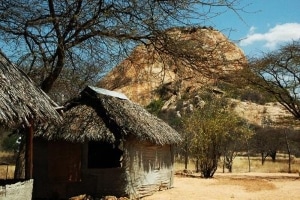
ABOUT KORA NATIONAL PARK
Kora national park was established in 1973 as a reserve and gazetted in 1989 as a park. The park covers an area of 1,788 square kilometers. The park offers pristine wilderness dotted with tall inselbergs, hard rocks and domed hills that rises steeply from the surrounding area and is featured with Tana River marked with Adamson’s falls, Grand falls and kora rapids. Moreover, the park slopes gently from an altitude of 490meter in the south-west and raising altitude of about 270 meter in the northeast above the sea level. The park gained its fame due to the wild exploits of George and Joy Adamson, with their friendly lioness called Elsa. The park had serious problems with poachers in the 1980s and 1990s. George Adamson and two of his assistants were murdered by poachers in the park in 1989. Adamson is buried in the park with three lions he released.
CLIMATE IN KORA NATIONAL PARK
The climate in Kora national park is favorable hot and dry all year round, therefore you should make an effort to visit the park and enjoy the marvels of the nature.
VEGETATION
Kora national park is characterized by a generally rugged environment with rock outcrops, granite kopjes, acacia woodland, and scrub as you head south to the Tana River which acts as habitant to wide range of animals.
WILDLIFE AND BIRDS OF KORA NATIONAL PARK
The diversity of animals to be explored in Kora national park include Caracals, Cheetahs, Hippos, Spotted Hyenas, Elephants, Hippos, Striped Hyenas, Serval cats, Lions, Leopards, Antelopes and many more. Kora national park is also an ideal birding spot with bird species such as Spot Flanked Barbet, Black-throated Barbet, Pel’s Fishing Owl, Eastern Yellow billed Hornbills, White-backed Night Heron, Orange-bellied Parrots, Busra Reed Warbler, Malindi Pipit and many more.
ACTIVITIES IN KORA NATIONAL PARK
Activities for tourists to engage in during a visit to Kora national park include;
- Rock climbing – Travelers who enjoy rock climbing adventures, Kora national park is one of the grateful places for you. Visitors can climb up the kora rock, a place of historical value where George Adamson would communicate out to the lions and they would respond to his call through roaring back and sometime they would gather around this rock.
- Game Viewing – A variety of wildlife species can be sighted in Kora national park and they include caracals, cheetahs, elephants, genets, hippos, spotted hyenas, striped hyenas, serval cats, antelopes among others. Game drives take place at different times of day, that is; morning game drives, full-day game drives, and evening game drives. Morning game drives are very rewarding to the tourists as the wildlife species are more active
and easy to see. Full day game drives allow the tourists to see the wildlife species at different times of the day and observe their way of life in terms of survival, feeding and relationship with others. During the evening game drives, the wildlife species may be a little difficult to spot due to the fact that they seek shelter at this time of day and are in hiding. - Fishing – This is done in the Tana river within Kora park with a great number of the local communities depending on fishing for a living. Tana river is associated with a variety of river forms such as oxbows, meanders, sandy floodplains, and many other features. Fishing on the Tana River depends on the change in tide and this has greatly influenced fishing in Kora national park along the Tana River.
- Guided Nature Walk – Tourists can engage in guided walks along the forest river lines and also in different trails that offers rewarding sights of different wildlife species and beautiful scenery of the landscape.
ATTRACTIONS
- Tana river with Adamson’s falls – Located not far from Kampi ya Simba, it is the only source of water for both wildlife and people in Kora national park with an exception of the rainy season where the various rocky outcrops provided optional water sources in form of pools. There are different attractions that can be seen along this river that include the Adamson’s Falls, Grand Falls, and Kora rapids.
- Wildlife species and birds – Wildlife include caracals, cheetahs, elephants, genets, hippos, spotted hyenas,
striped hyenas, serval cats, antelopes, and many other wildlife species. These wildlife species have proved fascinating as they can be spotted among spaced spreading trees and savannah grasslands, among rock outcrops as they graze and hunt. Birds include black-throated barbet, Pel’s fishing owl, eastern yellow billed hornbills, white-backed night heron, orange-bellied parrots, Busra reed warbler, Malindi pipit and many more. - Local Culture – Experience the local culture through interacting with the local communities such as the Asako village, Boka and Kamaguru in the eastern boundary of the national park. Some of these locals have become involved in the conservation in Kora national park and participate in tourism-related projects. These communities engage in subsistence agriculture and pastoralism on the borders of the national park.
ACCOMMODATION IN KORA NATIONAL PARK
Accommodation facilities in Kora national park range from luxury, midrange and budget. They offer quality services including safety, comfort and relaxation to tourists. They include; ; Leopard rock lodge, Elsa’s kopje lodge, Meru guest house, Kinna guest house, Murera cottages, Oribi guesthouse, Chui cottages, Simba cottages. Camping facilities on public campsites are available in different locations such as Kampi Baridi, Kitanga, Makutano, Rojoweru, Mugunga, Ken Mare, Kanjoo and Bwatherongi.
